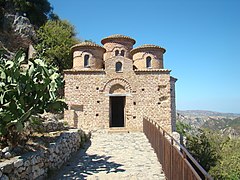Vallata dello Stilaro
Vallata dello Stilaro is a valley in the metropolitan city of Reggio Calabria in Calabria . The river Stilaro gives it its name . In the valley are the communities of Bivongi , Monasterace , Pazzano and Stilo .
The municipalities
The following table shows the population and area of the four municipalities.
| local community | Residents | surface |
|---|---|---|
| Bivongi | 1440 | 25.3 km² |
| Monasterace | 3541 | 15.0 km² |
| Pazzano | 681 | 15.0 km² |
| Stilo | 2739 | 78.5 km² |
history

The earliest evidence of human settlement dates from the eighth century BC, when the Greeks founded the city of Kaulon near the mouth of the Assi , which is estimated to have up to 10,000 inhabitants. Coins - so-called staters - were minted from the silver mined here . In the middle of the fourth century BC, the Stilaro, then called Elleporo , was the scene of a battle between the tyrant Dionysius I of Syracuse and the Italian League , which this union of several cities of the Magna Graecia lost.
In the 10th century, under the rule of the Byzantine Empire, there was an economic boom and population growth. Numerous small settlements emerged, so-called casali , with many monasteries, churches and hermit clauses , which were founded by the Greek monks of St. Basil . During this time, the town of Stilo became increasingly important.
On July 15, 982 there was a battle between Otto II and a Byzantine-Arab alliance, in which Emperor Otto was defeated.
In the 11th century, Stilo became Norman property. The first mention of a Norman castle in Stilo and also the first documents about the mining of minerals date from this time.
economy
The history of the region is closely linked to the extraction of iron ore. Silver was also extracted in ancient times. The Complesso siderurgico dell'Assi in the 18th century and the Mongiana steelworks in the 19th century were important locations for the iron and steel industry. In the 18th century an arms factory was built in Pazzano and a blast furnace in Stilo. In 1875 two short rail lines and a cable car were built to transport the minerals to the coast, where a small port in Monasterace was ready for shipping.
Today the economy is mainly agricultural : there is a strong production of olive oil and the cultivation of fruit. DOC wines are also produced in Bivongi . Sheep breeding is also practiced in the Stilaro-Allaro valley , as well as pecorino cheese and honey.
traffic
The valley is mainly accessed by two roads: the Strada Statale 106 , part of the European route 90 , which runs along the coast of the Ionian Sea through Monasterace Marina, and the SS 110, which connects Monasterace Marina with Stilo and Pazzano and continues through the Calabrian mountains to the Tyrrhenian Sea in western Calabria. Another transport route is the Ionian Railway from Catanzaro Lido to Reggio Calabria, whose regional trains also stop at the Monasterace Marina station.




